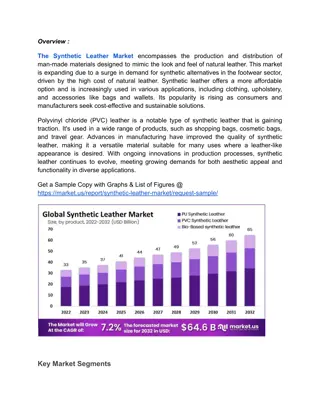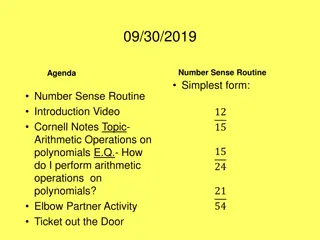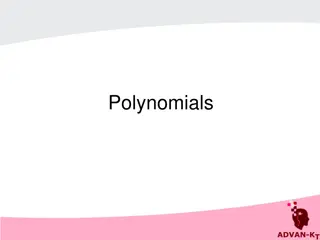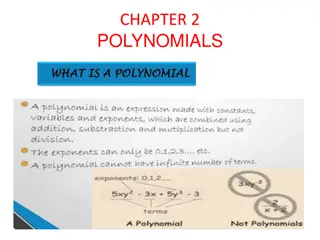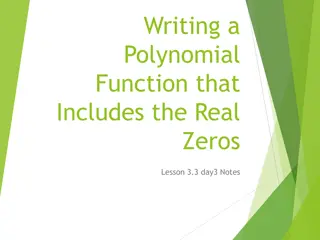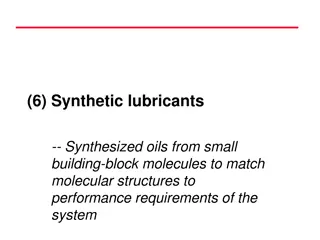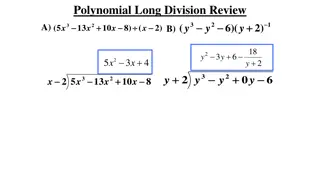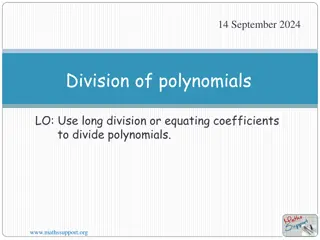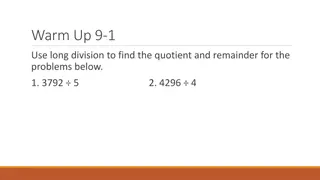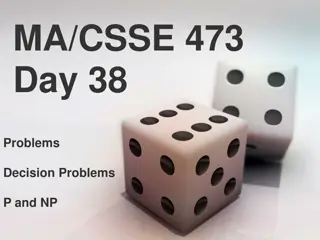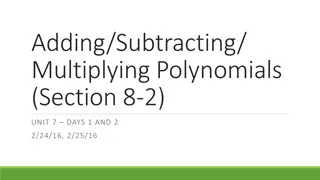Polynomial and Synthetic Division Techniques
Learn how to perform polynomial division using long division and synthetic division methods. Understand how to divide polynomials by other polynomials or binomials, utilize the Remainder Theorem and Factor Theorem, and apply these concepts through detailed examples.
Download Presentation

Please find below an Image/Link to download the presentation.
The content on the website is provided AS IS for your information and personal use only. It may not be sold, licensed, or shared on other websites without obtaining consent from the author. Download presentation by click this link. If you encounter any issues during the download, it is possible that the publisher has removed the file from their server.
E N D
Presentation Transcript
Polynomial and Synthetic Division
What you should learn How to use long division to divide polynomials by other polynomials How to use synthetic division to divide polynomials by binomials of the form (x k) How to use the Remainder Theorem and the Factor Theorem
1. x goes into x3? x2 times. 2. Multiply (x-1) by x2. 3. Change sign, Add. + + 2 x 2 6 x + + + 3 2 1 4 6 x x x x x x x x 4. Bring down 4x. 3 3 2 2 5. x goes into 2x2? 2xtimes. 6. Multiply (x-1) by 2x. 7. Change sign, Add + + + 2 4 2 2 x x x 0 2 2 x 2 2 x 0 + 2 x 8. Bring down -6. 9. x goes into 6x? 10. Multiply (x-1) by 6. 6times. + 6 6 6 6 6 0 x x x 6 11. Change sign, Add .
Long Division. x + 5 + + + 2 3 8 3 3 15 x x x x x x x 2+ 2 Check + + ( 3 )( 5 ) 5 3 x x x 5 + x 5 + x 5 x 15 15 0 15 = = + + + + + 2 15 x x 2 8 15 x x
+ + 3x 9 2x Divide. + + + 3 2 3 0 3 3 3 3 3 0 27 x x x x x x x x x x x 3 3 2 2 3 27 3 x + + 2 0 9 9 9 9 9 x x x x x x x 2 2 27 27 27 0 3 3 27 x x +
Long Division. x + 2 + 2 4 2 4 4 8 x x x x x x x 2 2 Check + 2 ( 2 )( 4 ) 4 2 x x x 2 x 2 x 2 x 8 8 0 + 8 = = + 8 x x 2 2 8 x x
Example 2 + p + 44 + 2 20 p = p +p 4 + 6 6 p + + + 2 6 2 6 20 p p p p p 2 2+ p 6 p Check 44 p + + + + + + 4 4 4 20 24 44 ( 6 )( ) 4 ( ) 6 p p p p p p + 6 24 = + + 2 4 6 24 44 p p p = + + 2 2 20 p p
Review Long Division. x + 2 + 2 4 2 4 4 8 x x x x x x x 2 2 Check + 2 ( 2 )( 4 ) 4 2 x x x 2 x 2 x 2 x 8 8 0 + 8 = = + 8 x x 2 2 8 x x
Synthetic Division - divide a polynomial by a polynomial To use synthetic division: There must be a coefficient for every possible power of the variable. The divisor must have a leading coefficient of 1. ( ( ) ) 6: + + + + 4 2 Ex x x x x 5 4 6 ( 3)
( ( ) ) 6 + + + + 4 2 x x x x 5 4 ( 3) Step #1: Write the terms of the polynomial so the degrees are in descending order. 5x4+ 0x3 4x2+x +6 Since the numerator does not contain all the powers of x, you must include a 0 for thex3.
( ( ) ) 6 + + + + 4 2 x x x x 5 4 ( 3) Step #2: Write the constant r of the divisor x-r to the left and write down the coefficients. 5x4+ 0x3 4x2+x +6 3 -4 6 1 5 0 Since the divisor is x-3, r=3
( ( ) ) + + + + 4 2 x x x x 5 4 6 ( 3) Step #3: Bring down the first coefficient, 5. 3 5 0 -4 1 6 5
( ( ) ) 6 4 2 + + + + x x x x 5 4 ( 3) Step #4: Multiply the first coefficient by r, so 3 5 and place under the second coefficient then add. = = 15 3 5 0 -4 1 6 15 15 5
( ( ) ) 6 4 2 + + + + x x x x 5 4 ( 3) Step #5: Repeat process multiplying the sum, 15, by r; and place this number under the next coefficient, then add. = = 15 3 45 3 5 0 -4 1 6 15 45 41 15 5
( ( ) ) 6 4 2 + + + + x x x x 5 4 ( 3) Step #5 cont.: Repeat the same procedure. Where did 123 and 372 come from? 3 5 0 -4 1 6 15 45 41 123 124 372 378 15 5
( ( ) ) 6 4 2 + + + + x x x x 5 4 ( 3) Step #6: Write the quotient. The numbers along the bottom are coefficients of the power of x in descending order, starting with the power that is one less than that of the dividend. 3 5 0 -4 1 6 15 45 41 123 124 372 378 15 5
( ( ) ) 6 4 2 + + + + x x x x 5 4 ( 3) The quotient is: 5x3+15x2+ 41x +124 +378 x 3 Remember to place the remainder over the divisor.
Synthetic Division Divide x4 10x2 2x + 4 by x + 3 1 0 -10 -2 4 -3 -3 +9 -3 3 -1 1 1 1 -3 3 + 4 2 1 + 10 2 4 x x x + 3 2 +x = 3 1 x x x + 3 x
x + 1 1 -2 -8 3 2 3 2 3 3 8 x x x x x x x 3 3 2 2+ -5 1 1 8 3 5 x x x + 3 = = = = 2 2 ( ) 2 8 f x x x ) 3 ( f ) 3 ( 9 ) 3 ( 2 8 8 5 6
The Remainder Theorem If a polynomial f(x) is divided by x k, the remainder is r = f(k). x + 1 2 3 2 3 3 8 x x x x x x x = = = = 2 2 ( ) 2 8 f x x x 2 2+ ) 3 ( f ) 3 ( 9 ) 3 ( 2 8 8 5 8 3 5 x x 6 x + 3
The Factor Theorem A polynomial f(x) has a factor (x-k) if and only if f(k)=0. Show that (x-2) is a factor of: ? ? = 2?4+ 7?3 4?2 27? 18 ? 2 = 2(24) + 7 23 4 22 27 2 18 ? 2 = 32 + 56 16 26 18 ? 2 = 0 2 7 -4 -27 -18 +2 4 22 18 36 9 0 2 11 18
Uses of the Remainder in Synthetic Division The remainder r, obtained in synthetic division of f(x) by (x k), provides the following information. 1. r = f(k) 2. If r = 0 then (x k) is a factor of f(x). 3. If r = 0 then (k, 0) is an x intercept of the graph of f.
Theorems About Roots of Polynomial Equations Rational Roots
Consider the following . . . x3 5x2 2x + 24 = 0 This equation factors to: (x+2)(x-3)(x-4)= 0 The roots therefore are: -2, 3, 4
Take a closer look at the original equation and our roots: x3 5x2 2x + 24 = 0 The roots therefore are: -2, 3, 4 What do you notice? -2, 3, and 4 all go into the last term, 24!
Spooky! Lets look at another 24x3 22x2 5x + 6 = 0 This equation factors to: (2x+1)(3x-2)(4x-3)= 0 The roots therefore are: 1 2,2 3,3 4
Take a closer look at the original equation and our roots: 24x3 22x2 5x + 6 = 0 This equation factors to: (2x+1)(3x-2)(4x-3)= 0 The roots therefore are: 1 What do you notice? 2,2 3,3 4 The numerators 1, 2, and 3 all go into the last term, 6! The denominators 2, 3, and 4 all go into the first term, 24!
This leads us to the Rational Root Theorem = + + + + n n 1 Y a x a x ... a x a 0 1 n 1 n For a polynomial, If ? ? is a root of the polynomial, then p is a factor of ?? and q is a factor of ?0
+ = 3 2 x x 3 x 3 0 1. For polynomial Here p = -3 and q = 1 Factors of -3 Factors of 1 3, 1 1 Or 3,-3, 1, -1 Possible roots are ___________________________________ + + + = 3 2 3 x 9 x 4 x 12 0 2. For polynomial Here p = 12 and q = 3 Factors of 12 Factors of 3 12, 6 , 4 , 3 , 2 1 3, 1 Possible roots are ______________________________________________ ?? 12, 6, 4, 3, 2, 1, 4 3, 2 3, 1 3 Where did all of these come from?
Lets look at our solutions 12, 6 , 4 , 3 , 2 1 3, 1 12 12 = = 4 12 3 1 Note that + 2 is listed twice; we only consider it as one answer 6 6 = 2 = 6 3 1 3 3 = 1 = 3 3 1 2 2 2 = = 2 Note that + 1 is listed twice; we only consider it as one answer 3 3 1 1 1 1 = = 1 3 3 1 4 4 4 = = 4 3 3 1 Note that + 4 is listed twice; we only consider it as one answer That is where our 9 possible answers come from!
Lets Try One Find the POSSIBLE roots of 5x3-24x2+41x-20=0
Lets Try One 5x3-24x2+41x-20=0 ? = 20 ??????? ?? 20 ??? 20, 10, 5, 4, 2, 1 ? = 5 ??????? ?? 5 ??? 5, 1 The possible roots are: 20, 10, 5, 4 , 2, 1, 4 5, 2 5, 1 5
Thats a lot of answers! Obviously 5x3-24x2+41x-20=0 does not have all of those roots as answers. Remember: these are only POSSIBLE roots. We take these roots and figure out what answers actually WORK.
Step 1 find p and q Step 2 by RRT, the only rational root is of the form p = -3 q = 1 Factors of p Factors of q
Step 3 factors Step 4 possible roots Factors of -3 = 3, 1 Factors of 1 = 1 -3, 3, 1, and -1
Step 5 Test each root Step 6 synthetic division X X + X 3x 3 1 1 -3 -3 -1 -3 (-3) + (-3) 3(-3) 3 = -12 (3) + (3) 3(3) 3 = 24 3 3 -1 0 (1) + (1) 3(1) 3 = -4 1 1 0 -3 0 (-1) + (-1) 3(-1) 3 = 0 -1 THIS IS YOUR ROOT BECAUSE WE ARE LOOKING FOR WHAT ROOTS WILL MAKE THE EQUATION =0 1x + 0x -3
Step 7 Rewrite Step 8 factor more and solve x + x - 3x - 3 = (x + 1)(x 3) (x + 1)(x 3) (x + 1)(x 3)(x + 3) Roots are -1, 3
Step 1 find p and q Step 2 by RRT, the only rational root is of the form p = -6 q = 1 Factors of p Factors of q
Step 3 factors Step 4 possible roots Factors of -6 = 1, 2, 3, 6 Factors of 1 = 1 -6, 6, -3, 3, -2, 2, 1, and -1
Step 6 synthetic division Step 5 Test each root X x 5x + 8x 6 -450 -6 1 -5 8 -6 3 78 6 0 THIS IS YOUR ROOT 3 6 3 -6 -102 -3 1 -2 2 0 -2 2 -50 -2 -2 1 1x + -2x + 2 -20 -1
Step 7 Rewrite Step 8 factor more and solve (x - 3)(x 2x + 2) x 5x + 8x 6 = (x - 3)(x 2x + 2) Quadratic Formula ? = ? ? = ? ? Roots are 3, 1 ?




